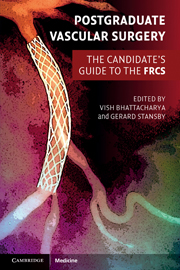Introduction to the examination and clinical cases
Summary
Popliteal aneurysm
The basics
Popliteal aneurysms (PAs) are the commonest peripheral aneurysm (Figure I.1). Approximately half are bilateral and half are associated with an aortic aneurysm. Conversely, 5–10% of patients with an abdominal aortic aneurysm (AAA) have a PA. The majority of PAs present with distal ischaemic complications in either the acute or chronic situation. The prevalence of the PA is thought to be around 1% for those in their eighth decade. When presenting acutely with distal limb ischaemia, limb loss occurs in up to 50% of cases. PAs almost exclusively occur in males. When treatment is indicated PAs are generally treated by surgical exclusion although endovascular management is a newer development in selected cases. Occasionally patients with patent PAs and very diseased run-off may be managed long term with anticoagulation to reduce the risk of aneurysm thrombosis.
The case
Popliteal aneurysms are usually easy to identify as an expansile, or prominent, pulsation in the popliteal fossa. The artery is best palpated against the tibia in the midline of the popliteal fossa, with the knee in the extended position (or with a few degrees of flexion). The artery can also be palpated with the knee flexed to 130°; in this position the popliteal fascia loosens to aid palpation. However, in doing so the manoeuvre deepens the artery from the skin surface. When thrombosed, PAs may be more difficult to diagnose clinically. It is important to assess the distal circulation for evidence of embolisation into the foot or calf vessels.
- Type
- Chapter
- Information
- Postgraduate Vascular SurgeryThe Candidate's Guide to the FRCS, pp. 3 - 34Publisher: Cambridge University PressPrint publication year: 2011



